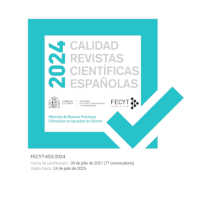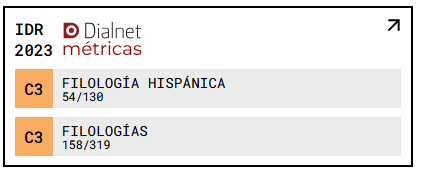The presence of Cervantes’s traces in the farcical cycle of Federico García Lorca
DOI:
https://doi.org/10.18172/cif.2657Keywords:
Entremés, Cervantes, Lorca, farce, freedom, traditionAbstract
Along his life, Federico García Lorca declared several times his debt with the Golden Age Theatre, especially with the entremeses or short plays of Miguel de Cervantes. The entremeses become, in the hands of the playwright from Granada, the root of which shape can be given to the framework in which farcical cycle is spun. The Cervantes’s entremeses appeared as a source of characters, subject matters and human tones with which the poet writes three farces in which aims to reintroduce traditional subject matters to build up a mythical, universal and timeless space that becomes the world’s mirror which stifles those individuals who stay out of what was established by society.Downloads
References
ALLARDYCE, N. (1977). El mundo de Arlequín. Estudio crítico de la Commedia dell’arte, Barcelona: Barral.
ASENSIO, E. (1971). Itinerario del entremés. Madrid: Gredos.
ASENSIO, E. (1981). “Introducción” en Entremeses (Miguel de Cervantes). Madrid: Castalia.
BAJTIN, M. (1974). La cultura popular en la Edad Media y el Renacimiento. Barcelona: Seix Barral.
CANAVAGGIO, J. (1983). “García Lorca ante el entremés cervantino” en El teatro menor en España a partir del siglo XVI. Actas del Coloquio celebrado en Madrid, 20-22 de mayo de 1982. Madrid: CSIC. (Anejos de la Revista Segismundo, 5).
CARDINALI, A. (1998). “Introducción” en Títeres de Cachiporra. Tragicomedia de don Cristóbal y la señá Rosita (Federico García Lorca). Madrid: Cátedra.
CERVANTES, M. de (2000). Entremeses. Madrid: Cátedra.
CERVANTES, M. de (2005). Novelas Ejemplares. Barcelona: Galaxia Gutenberg.
FERNÁNDEZ CIFUENTES, L. (1986). García Lorca en el teatro: la norma y la diferencia. Zaragoza: Prensas Universitarias de Zaragoza.
FERNÁNDEZ CIFUENTES, L. (1992). “El viejo y la niña: tradición y modernidad en el teatro de García Lorca” en El teatro en España. Entre la tradición y la vanguardia (1918-1939). (Coord. Dru Dougherty y María Francisca Vilches de Frutos). Madrid: CSIC-Fundación Federico García Lorca.
GARCÍA LORCA, F. (1996). Obras Completas II. Teatro. Barcelona: Galaxia Gutenberg.
GARCÍA LORCA, F. (1992). Retablillo de don Cristóbal y doña Rosita. Aleluya popular basada en el viejo y desvergonzado guiñol andaluz (versión inédita de Buenos Aires) (ed. Mario Hernández). Granada: Diputación Provincial de Granada.
GARCÍA LORCA, F. (1997). Obras Completas III. Prosa. Barcelona: Galaxia Gutenberg.
GARCÍA LORCA, F. (1990). Federico y su mundo. Madrid: Alianza.
HERNÁNDEZ, M. (1982). “Una criatura quijotesca: La zapatera prodigiosa (Cervantes, Falla, García Lorca)”. Teatro en España 10: 46-53.
HUERTA CALVO, J. (1995). El nuevo mundo de la risa. Estudios sobre el teatro breve y la comicidad en los Siglos de Oro. Palma de Mallorca: José J. de Olañeta editor.
HUERTA CALVO, J. (ed.) (2008). Historia del teatro breve en España. Madrid, Iberoamericana-Vervuert. DOI: https://doi.org/10.31819/9783964563491
JOSA FERNÁNDEZ, L. (2003). “De farsa humana eterna… Federico García Lorca y Cervantes” en Theatralia. El teatro de Miguel de Cervantes ante el IV Centenario. Pontevedra: Mirabel.
PERAL VEGA, E. J. (2001). Formas del teatro breve español en el siglo XX (1892-1939). Madrid: Fundación Universitaria Española.
PERAL VEGA, E. J. (2004). “Morir y matar amando: Amor de don Perlimplín con Belisa en su jardín”. Arbor 699-700: 691-702. DOI: https://doi.org/10.3989/arbor.2004.i699/700.604
SPADACCINI, N. (2000). “Introducción” en Entremeses (Miguel de Cervantes). Madrid: Cátedra.
UCELAY, M. (2005). “Introducción”, Amor de Don Perlimplín con Belisa en su Jardín. Madrid: Cátedra.
Downloads
Published
How to Cite
Issue
Section
License
The authors retain copyright of articles and authorize CIF the first publication. They are free to share and redistribute the article without obtaining permission from the publisher as long as they give appropriate credit to the editor and the journal.
Self-archiving is allowed too. In fact, it is recommendable to deposit a PDF version of the paper in academic and/or institutional repositories.
It is recommended to include the DOI number.
This journal is licensed under a Creative Commons Attribution 4.0 International License














